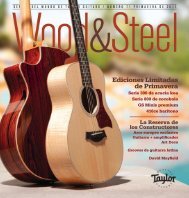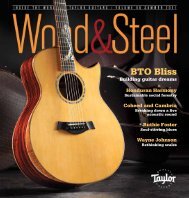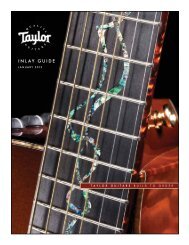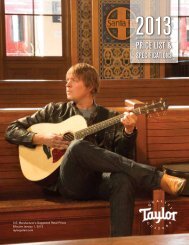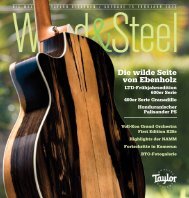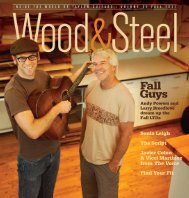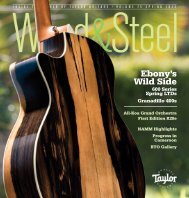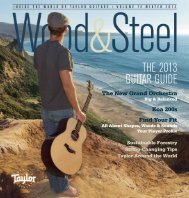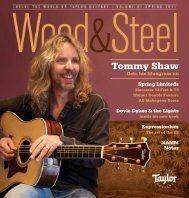The 2012 Taylor Line - Taylor Guitars
The 2012 Taylor Line - Taylor Guitars
The 2012 Taylor Line - Taylor Guitars
Create successful ePaper yourself
Turn your PDF publications into a flip-book with our unique Google optimized e-Paper software.
“To us the Koa Series is almost like<br />
the wood lover’s version of a Presentation<br />
Series guitar now,” Bob says. “It<br />
has that level of elegance.”<br />
Another area of focus within the<br />
acoustic/electric line was the 700<br />
Series, one of three series that feature<br />
the classic rosewood/spruce wood<br />
pairing. <strong>The</strong> design team saw an opportunity<br />
to better differentiate each rosewood<br />
series through the appointment<br />
packages. <strong>The</strong> 900 Series has long<br />
featured <strong>Taylor</strong>’s most sophisticated<br />
appointments, and last year returned<br />
to the popular “Cindy” vine inlay, with<br />
abalone trim and rich red purfling. <strong>The</strong><br />
iconic 800 Series bears a lineage to<br />
the models of <strong>Taylor</strong>’s early days and<br />
has long anchored the line as the quintessential<br />
rosewood/spruce guitar. <strong>The</strong><br />
appointments were updated several<br />
years ago to give it a more contemporary<br />
flair with a stylish fretboard inlay<br />
and figured maple binding. For the 700<br />
Series, the design team envisioned a<br />
more vintage aesthetic.<br />
“We wanted to build something<br />
that’s a nod to the old guitars we love,”<br />
Andy explains. “We wanted to make<br />
an inlay that looked straight out of the<br />
1930s, with pretty traditional material,<br />
so we’re using ivoroid, which we can<br />
engrave really well.”<br />
In addition to the Heritage Diamond<br />
fretboard inlay motif, all the other inlays<br />
and binding also feature ivoroid. Another<br />
retro touch included as a standard<br />
feature is a vintage sunburst top with a<br />
dark, gradual fade.<br />
“<strong>Taylor</strong> has a whole generation of<br />
history,” Andy says. “But this guitar is<br />
an idea of what <strong>Taylor</strong> might have built<br />
if we had two more generations of history.”<br />
For the maple/spruce 600 Series,<br />
the design team introduced a new<br />
Twisted Oval fretboard inlay originally<br />
inspired by a day Andy spent at a California<br />
lake with his wife.<br />
“I was sitting on the shore doodling<br />
while my wife was out on a kayak,” he<br />
recalls. “I was watching the way the<br />
ends of the paddle moved, twisting up<br />
and back. So I drew what I thought<br />
it looked like. Later we took that and<br />
morphed it until it became two interlocking<br />
pieces. <strong>The</strong>re’s a tiny nod to<br />
Escher in the way he would do his<br />
impossible knots.<br />
“It has a real clean, contemporary<br />
look and a sharpness to it with the<br />
points on the ends and the ovals and<br />
the ways the lines are flared,” he adds.<br />
“We thought the 600 Series was a<br />
great fit because it has a modern persona<br />
and because it’s the perfect stage<br />
guitar, between maple’s tonal crispness<br />
and the way the light-colored woods<br />
are compatible with all kinds of eyecatching<br />
colors.”<br />
A new design for the 500 Series<br />
honors mahogany’s rich heritage as a<br />
guitar wood, yet with a contemporary<br />
twist. <strong>The</strong> Deco Diamond fretboard<br />
inlay progresses from a square form<br />
into a more elaborately flared diamond.<br />
<strong>The</strong> pearloid inlay material (an Italian<br />
acrylic that we first used with our 2010<br />
Fall Limited Editions) was an appealing<br />
alternative to traditional pearl because<br />
it can be easily engraved with lasers,<br />
enabling the inlay to have an extra level<br />
of detail. Another aesthetic touch was<br />
to visually interpret mahogany’s warm<br />
GS Mini Mahogany<br />
tonal character with a dark brown stain<br />
on the back, sides and neck, accented<br />
with faux tortoise shell binding.<br />
<strong>The</strong> 400 Series also incorporates<br />
a new, laser-engraved pearloid inlay.<br />
<strong>The</strong> series has always projected a<br />
clean, contemporary look, which was<br />
enhanced with an engraved dot that<br />
progressively flattens out into an oval.<br />
<strong>The</strong> 300 Series welcomes a GS shape<br />
and incorporates slightly smaller fretboard<br />
inlay dots.<br />
Other minor appointment refinements<br />
to the acoustic/electric line<br />
include an optional tobacco sunburst<br />
top or all-black finish for the 200<br />
Series, and an upgrade to an inlaid<br />
rosette on the Baby <strong>Taylor</strong> and Big<br />
Baby.<br />
Nylon-Strings Join Steel-Strings<br />
One of the most sweeping changes<br />
to the acoustic/electric line is the<br />
integration of our nylon-string models<br />
into the line alongside our steel-string<br />
models. As a result, the nylon-string<br />
and steel-string guitars will now share<br />
appointment specifications within each<br />
series. New nylon-string models also<br />
were added to make them available<br />
from the 200-900 Series.<br />
“After years of building hybrid nylonstrings<br />
that are geared toward the modern<br />
steel-string player, we felt that they<br />
belong together with our steel-strings,”<br />
Bob explains. “Now you’ll have a choice<br />
of more wood pairings and have all the<br />
different visual aspects that relate to<br />
the steel-strings.”<br />
In the longterm, the nylon migration<br />
also clears the way for the eventual<br />
release of a pure classical guitar series,<br />
a project currently in development.<br />
Mahogany for the Mini and<br />
Specialty Models<br />
Several new acoustic models<br />
expand the ranks of our more unique<br />
guitar offerings. In response to the GS<br />
Mini’s wildly popular reception since<br />
its debut in 2010, a mahogany-top version<br />
is now available. <strong>The</strong> design team<br />
is excited about the new possibilities it<br />
offers players.<br />
“With the mahogany top, it might<br />
take a little longer to play in, but you’ll<br />
have this incredible blues machine,”<br />
Andy says. “It’s like the old mahoganytop<br />
guitars from the Depression era,<br />
where you’ve got this burly, punchy<br />
quality. <strong>The</strong>re will be times when players<br />
might prefer the spruce-top version,<br />
but if they want to play a little ragtime<br />
or blues, that mahogany-top is the one.<br />
It could also work as a slide instrument,<br />
with a taller nut. It’s really cool as a lap<br />
guitar, almost like a Weissenborn with<br />
a bottle neck. <strong>The</strong> short scale makes<br />
slants really easy, it handles some higher<br />
tunings really well, and you can do all<br />
kinds of fun stuff with it. And for what it<br />
costs, a person could buy one of those<br />
and dedicate it to a specific use. I even<br />
know players who will buy two or three<br />
of them, high-string one with that short<br />
scale, and set up another one for playing<br />
with a slide. Some guys keep them<br />
in different tunings as an alternate guitar.<br />
It’s a really versatile little piece.”<br />
Our baritone and 12-fret models<br />
also welcome a new addition in the<br />
form of mahogany versions that accompany<br />
the original rosewood models.<br />
“<strong>The</strong> nice thing about the mahogany<br />
baritones is the way the extra clarity<br />
works with the lower-pitch fundamental<br />
of the B tuning,” Andy says. “<strong>The</strong>y<br />
sound great.”<br />
12-Strings<br />
Another change for <strong>2012</strong> is a<br />
refinement of <strong>Taylor</strong>’s 12-string model<br />
selection. We’ve decided to make the<br />
GS the predominant body shape for<br />
our 12-strings, based on the natural<br />
compatibility of the body shape with<br />
our current 12-string design.<br />
“We’ve found that the GS makes a<br />
great 12-string because the waist has<br />
been shifted a little higher and pushed<br />
out a little more than a traditional<br />
Jumbo, so the top is a bit more flexible<br />
in some of those curves,” Bob explains.<br />
“Players get a more resonant, colorful<br />
sonic picture. It turned out that the GS<br />
shape delivers a lot of what players<br />
want to hear from a 12-string guitar.<br />
You have this beautiful, rich low end,<br />
with an even balance from the low to<br />
the high that gives it a pleasant ringing<br />
quality.”<br />
We’ve also pared down our selection<br />
of Grand Auditorium 12-strings to<br />
the GA3-12 and GA4-12. <strong>The</strong> Jumbo,<br />
meanwhile, is taking a temporary leave<br />
of absence from the line. <strong>The</strong> plan is<br />
for the design group to experiment with<br />
some new shape and voicing ideas to<br />
refine its tonal personality.<br />
<strong>The</strong> Electric <strong>Line</strong><br />
In its relatively brief history thus<br />
far, the <strong>Taylor</strong> electric line has quickly<br />
grown to encompass an expansive<br />
range of guitar styles and tones. Over<br />
the course of 2011 the SolidBody<br />
saw the addition of double cutaways,<br />
new colors, and new pickup configurations.<br />
<strong>The</strong> custom-ordering flexibility,<br />
together with the aftermarket Loaded<br />
Pickguards, gives players incredible<br />
aesthetic and tone-shaping control.<br />
For the hollowbody T5, a new<br />
Spires fretboard inlay was designed for<br />
Custom models, while the semi-hollowbody<br />
T3 is now available with additional<br />
pickup options, including vintage alnico<br />
and high-definition mini humbuckers,<br />
the latter of which the design team felt<br />
were a great match for the guitar.<br />
“Our mini humbuckers are fantastic<br />
pickups,” Andy says. “<strong>The</strong>y’re really balanced<br />
with a pretty character to them,<br />
but they also have this bold and punchy<br />
quality. At times they have almost a<br />
single-coil-like character in their clarity,<br />
with the power and noise-cancelling of<br />
a humbucker. You get the sparkle, the<br />
punch, the pop of a really good single<br />
coil, but put into a setting you can have<br />
a lot of fun with on stage. <strong>The</strong>se are<br />
unique, wonderful sounds that you can<br />
use to play rock, rockabilly, surf music,<br />
Merle Travis-style country, all kinds of<br />
stuff.”<br />
Builder’s Reserve:<br />
Ukuleles and Amps<br />
One of the more intriguing developments<br />
for <strong>2012</strong> isn’t formally part of the<br />
standard <strong>Taylor</strong> guitar line but is slated<br />
to make recurring appearances each<br />
quarter. Over the past several years<br />
we’ve made two batches of ultra-limited<br />
Builder’s Reserve guitars (one was a<br />
SolidBody Classic made from burled<br />
Bastogne walnut, the other a run of 50<br />
Liberty Tree T5 models featuring tops<br />
made of the historic wood). This year<br />
marks the return of Builder’s Reserve<br />
as a high-level design shop that<br />
allows us to craft very small batches<br />
of detail-rich instruments that are too<br />
labor-intensive to build through our<br />
standard guitar line. Andy’s arrival last<br />
year helped rekindle the spirit of superpremium,<br />
handmade craftsmanship that<br />
sets Builder’s Reserve apart.<br />
Two extraordinary Builder’s Reserve<br />
offerings are sure to make a stylish<br />
Andy Powers uses a rabbet plane to shave a ukulele’s oversize braces down to begin the top voicing. “I’ll work them<br />
slowly, going from one to the next until they all approach their finished size, monitoring the sound of the top as I go,”<br />
he explains. “I made that plane on my 13th birthday, and have used it on nearly every guitar I’ve made since.”<br />
entrance for <strong>2012</strong>. To celebrate the<br />
redesign of the Koa Series, we’re<br />
releasing 30 all-koa guitars that are<br />
each paired with a matching, handcrafted<br />
tenor ukulele also designed inhouse.<br />
It marks <strong>Taylor</strong>’s first non-guitar<br />
instrument offering and was made possible<br />
by Andy’s background in making<br />
high-end ukuleles.<br />
“Andy has been building ukes since<br />
he was a kid, and I mean for nearly<br />
20 years,” says Bob. “He knows what<br />
a good uke sounds like because he’s<br />
such a great player, and he knows<br />
how to build it to get there. His ukes<br />
feel and sound like real musical instruments.”<br />
<strong>The</strong> whole project came about on<br />
the fly, after Andy built a tenor uke on<br />
a whim using some koa that was too<br />
small to build a guitar with. He gave the<br />
uke to Bob to take home one weekend<br />
and have fun with it.<br />
“It was so much fun I couldn’t put it<br />
down,” Bob says. “So, we thought, let’s<br />
build some ukes by hand, and when we<br />
get a hankering to build more, we will.”<br />
All 30 will be built by hand because<br />
no tooling has been made for the ukes.<br />
<strong>The</strong> second Builder’s Reserve<br />
series is a limited release, <strong>Taylor</strong>designed<br />
acoustic amp that’s been simmering<br />
on the back burner for a while.<br />
“<strong>The</strong> amp and guitar pairing is also<br />
a complete first for us,” says Bob. “Our<br />
team has worked steadily for a few<br />
years, chipping away at a design for<br />
a high quality, yet portable acoustic<br />
guitar amp that sounds terrific with our<br />
Expression System. We’re really proud<br />
to hand-make these amps and offer<br />
them in limited quantities this year.”<br />
<strong>The</strong> ES Amp is optimized for<br />
ES-equipped guitars, which makes it<br />
remarkably transparent and simple to<br />
use since you shape your tone using<br />
the ES controls on a guitar (the only<br />
control on the amp is a volume knob).<br />
Instead of a full-blown product launch,<br />
we’ve decided to offer the amp this<br />
year in a quarterly series of Builder’s<br />
Reserve releases, in which we build<br />
a matching guitar and acoustic amp<br />
combo. Each quarter a different guitar<br />
and custom amp cabinet will be<br />
designed together and released in<br />
small batches. To read more about both<br />
Builder’s Reserve pairings, see the following<br />
page.<br />
Whether <strong>Taylor</strong>’s latest designs<br />
ultimately are offered through Builder’s<br />
Reserve or the standard <strong>Taylor</strong> line, the<br />
refinements that the team introduces<br />
are guided by a common underlying<br />
sense of aesthetic balance.<br />
“For us, an object is really successful<br />
when you can’t add a single thing or<br />
take a single thing away and have it be<br />
as good,” Andy reflects. “<strong>The</strong>re’s a certain<br />
‘just right’ quality about something<br />
when you’ve achieved the right balance<br />
between an object’s components.<br />
That’s the sweet spot. That’s what we<br />
aim for.”<br />
THE <strong>2012</strong> TAYLOR GUITAR GUIDE<br />
WALkING A FINE LINE<br />
15




